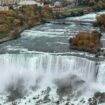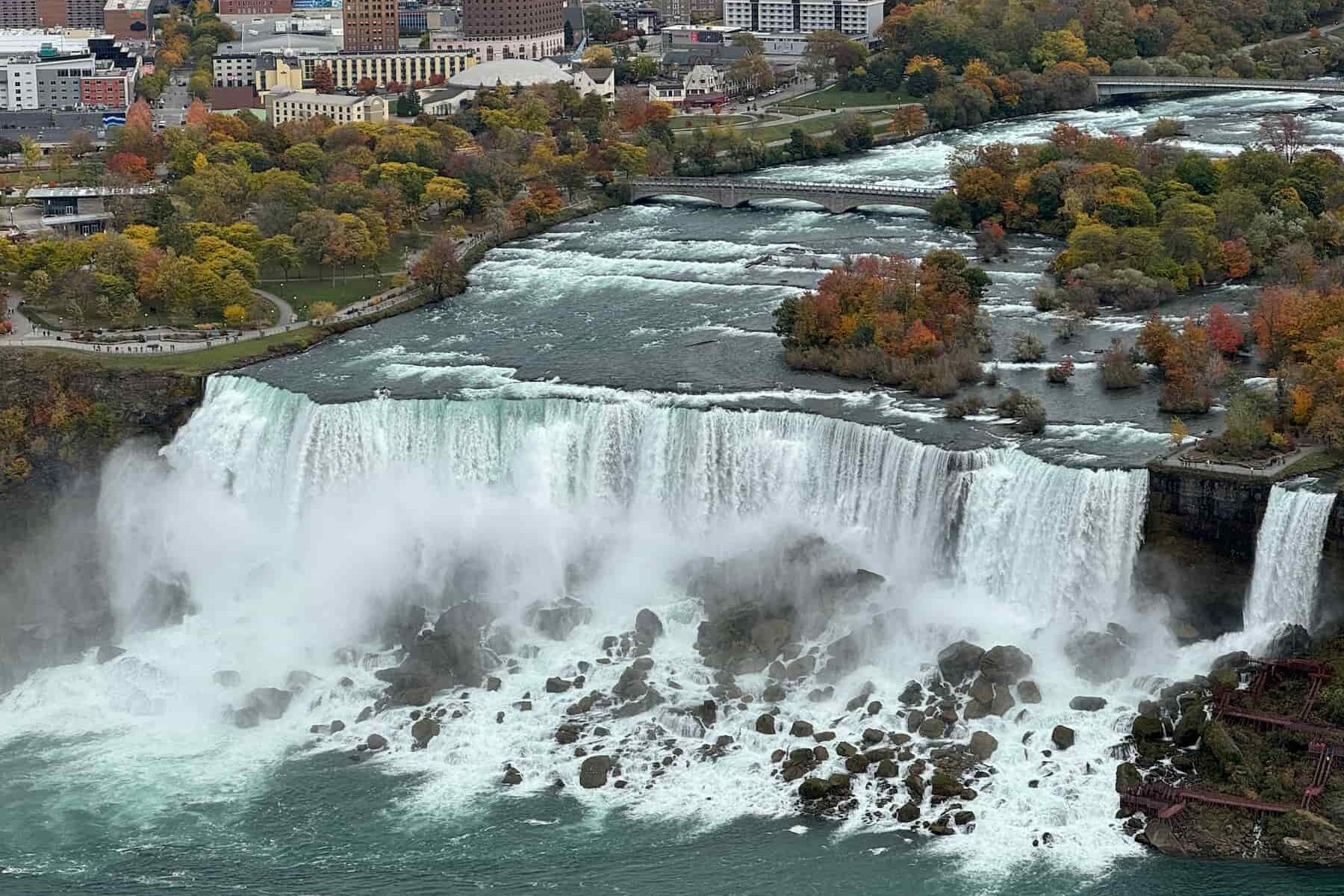
Go World Travel is reader-supported and may earn a commission from purchases made through links in this piece.
Niagara Falls’ unparalleled beauty and storied history is a magnet for tourists from around the world. They come to marvel at the grandeur and power of these spectacular formations, which straddle the U.S. (New York) and Canada (Ontario).
There are many attractions to experience during a visit to the Falls, both on the American and Canadian sides. First-timers may be overwhelmed with the choices and the logistics involved in accessing the various options.
I highly recommend doing a tour encompassing a number of the main sights to simplify matters. Not only does this eliminate transportation, tolls, and parking issues, but it also takes care of admission fees.
And equally important – you’ll get plenty of information about all things Niagara Falls from a knowledgeable and entertaining guide.
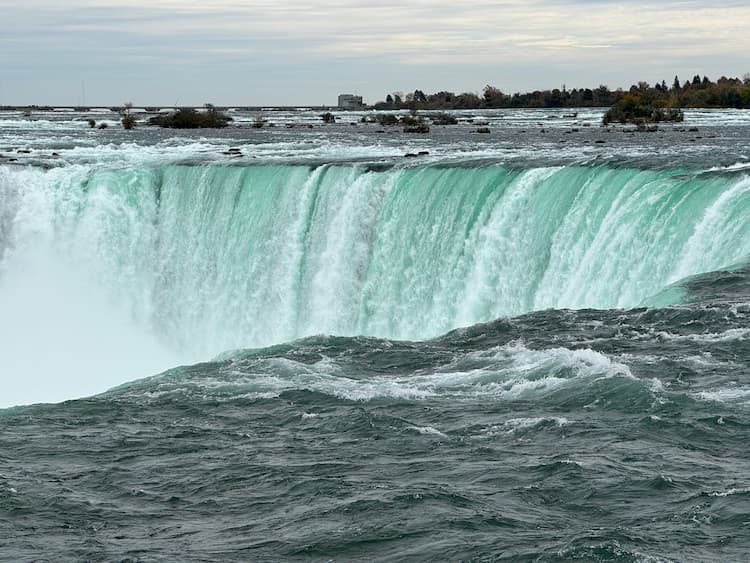
Get the Full Two-Sided Experience on an Over the Falls Tour
Over the Falls Tours is a top-rated, family-owned and operated company in Niagara that’s been taking tourists to the Falls since 1994. It offers both group and custom-private tours to the American and Canadian sides.
The most popular is the “Niagara Falls Canadian and American Tour with Maid of the Mist Boat Ride.” For this tour, you’ll need your passport, as you will cross the international border.
This six-seven-hour experience includes the Cave of the Winds, Maid of the Mist and Niagara State Park on the American side, plus Skylon Tower and a trip along Niagara’s mighty River Gorge on the Canadian side.
It’s an all-encompassing excursion that gives you a taste of the highlights and is ideal for those who only have one day to spend at this iconic destination.
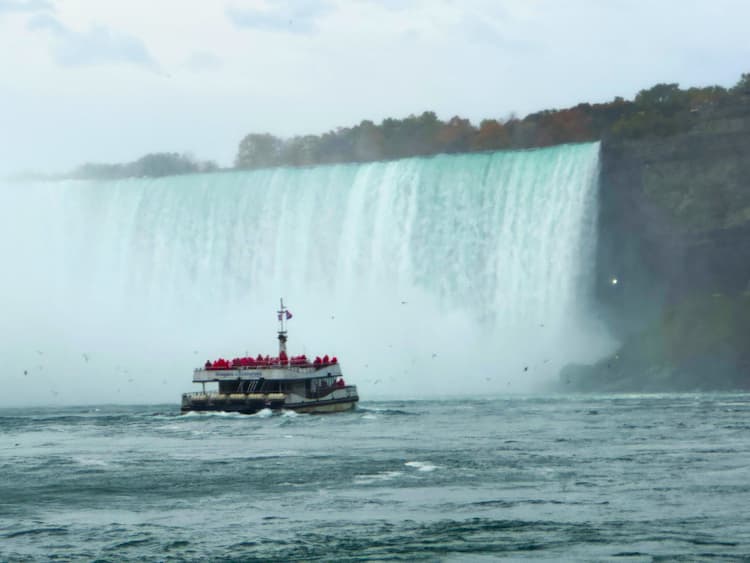
Eye-Opening Facts About the Falls
During your tour, you’ll learn many facts about the Falls. To begin with, this famed landmark is actually comprised of three separate waterfalls: American Falls, Bridal Veil Falls (named for its resemblance to a bride’s veil), and Horseshoe Falls, which is the largest.
The latter is located mostly on the Canadian side of the Niagara River, while the American and Bridal Veil Falls are situated completely on the American side, within Niagara Falls State Park.
As for measurements, Horseshoe is 188 feet high with a crestline (width) of 2,200 feet, whereas American Falls ranges from 70-110 feet high (depending on whether you measure from the top of the falls to the river rather than to the top of the talus or rock pile, which was formed by the tumbling bedrock the flow has pushed over the waterfalls).
Planning a last-minute trip to New York?
Top Experiences and Tours in New York:
- See the sights with a tour of NYC: Museum of Modern Art (MoMA) Timed-Entry Ticket
- See more with NYC: SUMMIT One Vanderbilt Experience Ticket
- Explore New York with Go City®
Where to stay and transportation in New York:
- Find accommodation with Agoda
- Book a hotel through Booking.com
- Find a rental car through RentalCars.com
Its crestline is about 1,000 feet. And Bridal Veil measures 181 feet high with a crestline of 50 feet.
The history of the Falls dates back some 12,000 years ago when large amounts of water were released from the melting ice of glaciers, draining into what is now known as the Niagara River.
This body of water’s flow gradually cut a gorge through the north-facing cliff, eroding the layer that supported the hard layers of what is known as the Niagara Escarpment. To put it simply, the erosion process caused large chunks of rock to break off and tumble, giving shape to the Falls.
About 3,160 tons of water flows over Niagara Falls every second and it drops at 32 feet per second, hitting the base of the falls with 280 tons of force for the American and Bridal Veil Falls, and a whopping 2,509 tons of force at Horseshoe Falls. Hard to fathom these numbers!
Hydroelectricity is one of Niagara Falls’ most important products. It’s the largest producer of electricity in NY State. Together, power plants on both the American and Canadian sides of the Falls have the capacity to produce up to 2.4 million kilowatts of electricity. Another massive stat!
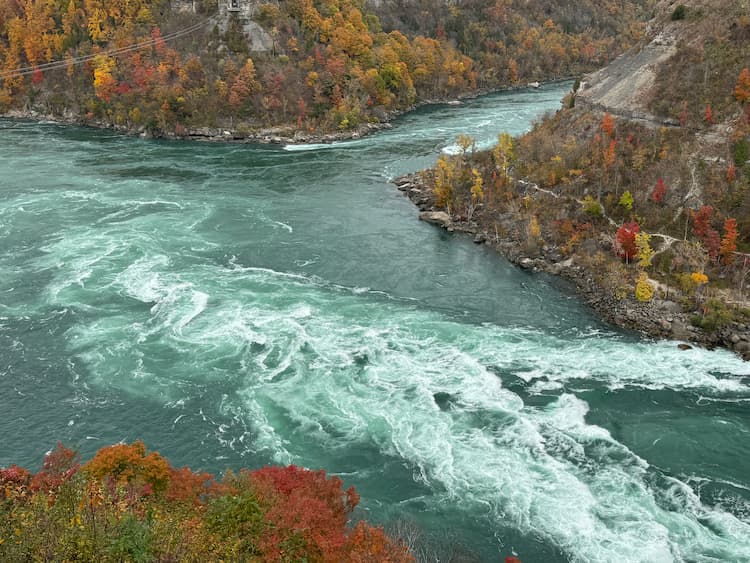
Human History Is an Important Part of the Falls
Native Americans living in the region were most likely the first people to see the Falls and behold its power. Later, a French priest, Father Louis Hennepin, was the first European to document the area during a 1678 expedition.
He published an account of his travels in a book, which then brought Niagara Falls to the attention of the Western world, inspiring curiosity and further exploration in the region.
Best Tips & Tools to Plan Your Trip
Railways opened Niagara Falls to the masses in the 1800s, making it a sought-after destination for travelers. The story has it that Napoleon Bonaparte’s younger brother, Jerome, honeymooned with his American bride at the Falls. He is supposedly credited with starting its honeymoon tradition, which continues today.
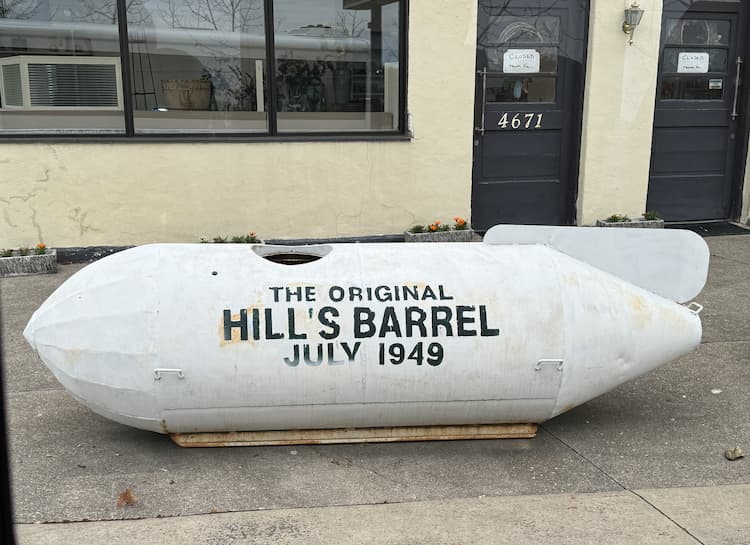
Hear About Those Who Dared to Go Over the Falls
During the tour, your guide will also regale you with stories about a few of the people (there have been more than 5,000) who have gone over or attempted to go over the Falls, either intentionally (as stunts or suicide attempts) or accidentally, since 1850. The vast majority perished.
The first recorded person to survive this feat was 63-year-old schoolteacher Annie Edson Taylor, from Michigan, who in 1901 successfully completed the stunt inside an oak barrel. Taylor designed a barrel that included pillows and cushions and sent her cat in it first. Thankfully, the cat made it alive, as did Taylor.
In 1960, 7-year-old Roger Woodward unintentionally plunged over the Falls in nothing but a swimsuit and a life jacket when the boat he was on with his family capsized.
His father died in the water and his sister was saved before she got to the Falls, but Roger went over the Falls and survived. He was saved by a tourist cruise boat at the bottom of the Falls.
Steven Trotter and Lori Martin rode the Falls in 1995 in a barrel built out of water heaters lined with fiberglass. They were the first man-and-woman duo to make it down the Falls alive.
That same year, Californian Robert Overracker attempted it on a jet ski. He had a rocket-propelled parachute strapped to his back and the plan was to float down after flying off the Falls. But the parachute didn’t work and tragically, he fell to his death.
If you have any ideas about attempting this crazy act, know that it’s illegal to do so and you will be fined $10,000. Definitely not on my bucket list!
Observation Tower Offers the Best View of All 3 Falls
You’ll get your first good look at the Falls from the Observation Tower on the American side. It’s the only panoramic viewpoint of all three Niagara Falls. The sight is breathtaking and you’ll ooh and aah with the rest of the folks, while taking countless pics.
You’ll then take an elevator down to the base of the gorge where the Maid of the Mist dock is located. Don the souvenir rain poncho given to you and don’t worry about making a fashion statement. Just be happy you have some protection from the blasts of spray because you will get wet!
A Ride on the Maid of the Mist Gets You Up Close and Personal with the Falls
The boat ferries past the base of the American Falls and onto the basin of Horseshoe Falls, a dramatic passage that leads you through the fiercely roiling whitewater and massive rock formations.
If you want to experience the full force of the spray, head to the top of the boat’s deck. Yes, you’ll get completely drenched, but the experience is one for the memory books. It’s only water, right?
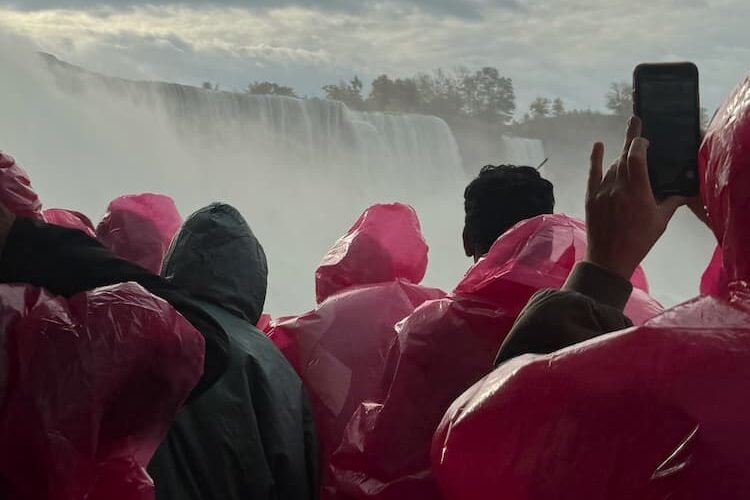
Prepare to Get Wet Again at the Cave of the Winds
The Cave of the Winds, which is located on Goat Island, is another highlight of the tour. The name “Cave of the Winds,” as you’ll learn, is a bit deceiving. In the 1800s, there was a rock overhang or a cave-like formation that allowed people to stand under the Falls. This structure collapsed in the early 1900s, but the name stuck.
Before you reach the Cave of the Winds, you’ll pass through “The World Changed Here Pavilion.” Via exhibits and an immersive multimedia experience, you’ll hear how Nikola Tesla was able to harness the power of the Falls to create an alternating current.
And you’ll see what the Falls looked like prior to becoming a park. It was the Free Niagara Movement that helped to preserve the beauty of the Falls for future generations and inspired a model for public parks around the world, serving as the first American – and New York – State Park (established in 1885).
Then it’s time to get ponchos again, or use the ones you already have, and descend 175 feet via elevator into the Niagara Gorge. Exit and find yourself on a series of wooden walkways, where your guide will bring you to several wooden decks. The “Hurricane Deck” puts you within feet of the crashing Bridal Veil Falls.
Unfortunately, when I visited, this deck was in the process of being removed. It’s removed every fall and rebuilt in the spring, as during the winter, the icefall hits the deck and the build-up of ice below gets too heavy.
But there’s another deck, about 150 feet from the base of the Falls, that remains year-round and offers a good perspective. Thus, I was still able to witness the torrents, sans the intensity.
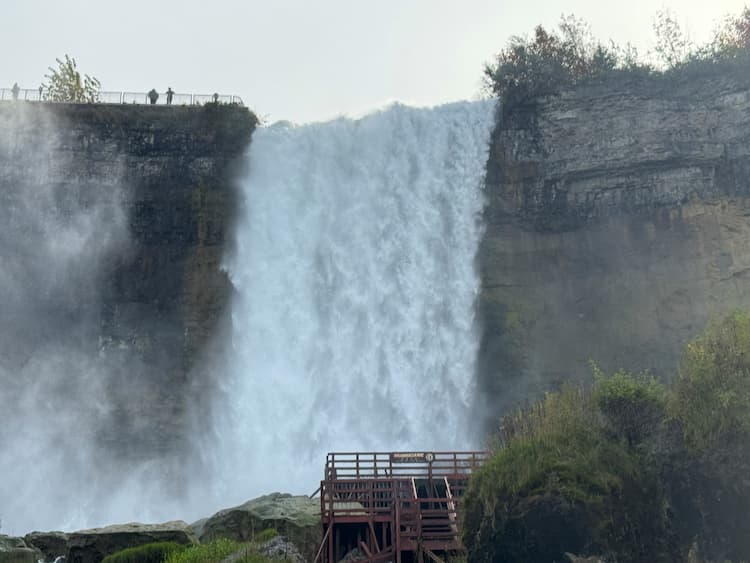
The Canadian Side Offers Its Own Dramatic Scenes
On the Canadian side of Niagara Falls, you’ll drive along the scenic Niagara River Parkway with views of the picturesque River Gorge. One of the highlights on this route is the magnificent Niagara Whirlpool, which you’ll be able to see from an observation platform.
The whirlpool is caused by the huge volume of water rushing from the Falls and being crushed into the narrow gorge. The swirling waters create a vortex, or whirlpool with rapids that stretch for one mile. It’s as deep as 125 feet here and the speed of the water can reach up to 22 mph.
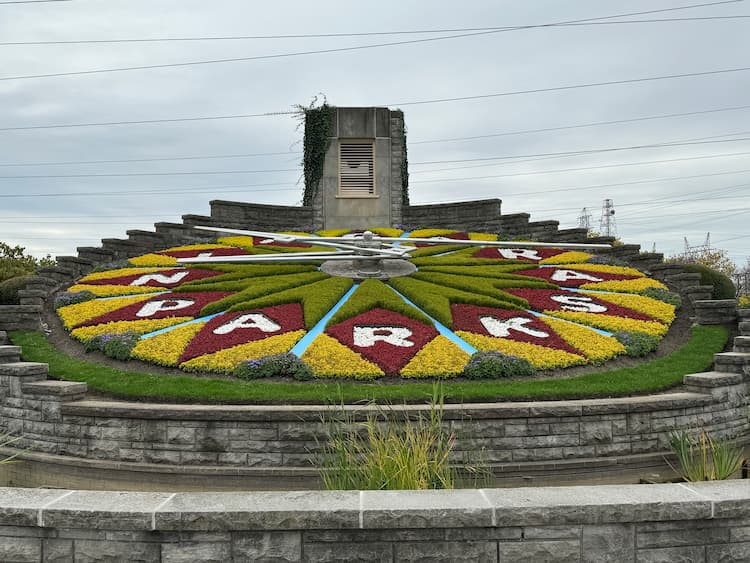
Get Your Cameras Ready for the Famed Flora Clock
Also along the Parkway is the famous Flora Clock. Measuring forty feet in diameter, the face of the clock is filled with as many as 16,000 carpet plants and annuals. Expert horticulturists and students from the Niagara Parks School of Horticulture design and plant the faces.
Each design is unique and can never be repeated. The tower at the back of the clock houses Westminster chimes that ring on the quarter hour.
Table Rock Centre Will Take Your Breath Away
Another memorable stop on the Canadian side is Table Rock Centre. Perched atop Horseshoe Falls, this point presents a dramatic panorama of both the American Falls and the mighty Horseshoe Falls. You can get right up to the brink of the latter and it’s monstrous!
Ascend Skylon Tower for a Bird’s Eye View of the Falls
The last highlight on the tour is Skylon Tower, a signature landmark. Standing 520 feet high, the tower is modeled after the Space Needle in Seattle. Ascend the elevator to the indoor/outdoor observation deck to get a bird’s eye perspective of the Falls.
Opt to return later to enjoy a special meal at the Skylon Tower Revolving Dining Room. Or check out Niagara’s largest indoor amusement area, Skylon Fun Centre, for family fun. And if you need more adventure, check out Zipline Niagara Falls or Journey Behind the Falls.
Walk, Don’t Ride Across Rainbow Bridge
On the return journey, you can choose to get dropped off at your hotel or walk across Rainbow Bridge, which takes you from Canada back into the U.S. I decided to walk and I recommend this option.
It costs pedestrians only $1 to cross the bridge and the incentive is the excellent view of the Falls. Plus, it’ll only take you about fifteen minutes to complete the span.
www.overthefallstoursniagara.com
Inspire your next adventure with our articles below:
Author Bio: Debbie Stone is an established travel writer and columnist, who crosses the globe in search of unique destinations and experiences to share with her readers and listeners. She’s an avid explorer who welcomes new opportunities to increase awareness and enthusiasm for places, culture, food, history, nature, outdoor adventure, wellness and more. Her travels have taken her to nearly 100 countries spanning all seven continents, and her stories appear in numerous print and digital publications.
- Travel Guide to Colorado - April 26, 2024
- Travel Guide to Croatia - April 26, 2024
- Top 10 Things to Do in Ireland - April 25, 2024

